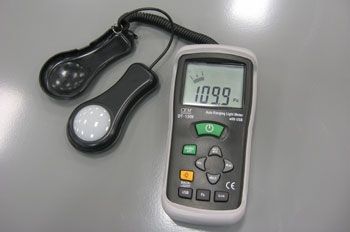Springtime Structural Integrity Inspections: How NDT Prevents Failures
May 1, 2025
Spring is a time of renewal and growth, but it's also the perfect season to ensure that buildings and structures remain safe and sound. As temperatures rise and the snow melts away, it's crucial to conduct thorough structural integrity inspections. One key method for conducting these inspections is through Non-Destructive Testing (NDT). NDT plays a vital role in detecting potential failures and ensuring the longevity of your structures without causing any damage to them.
In this article, we'll explore the importance of building inspections, delve into the world of NDT, and discuss how these inspections can prevent structural failures.

Photo By: Bustamante Engineers
The Importance of Building Inspections
Building inspections are a critical component of maintaining the safety and functionality of structures. They help identify any potential issues that could compromise the structural integrity of a building, such as cracks, corrosion, or other forms of deterioration. Regular inspections can catch these problems early, allowing for timely repairs and preventing more severe issues down the line.
Why Springtime?
Spring is the ideal time for structural inspections due to the changing weather conditions. During winter, buildings may experience stress from snow, ice, and freezing temperatures, which can lead to hidden damage. As the weather warms up, it's easier to spot these issues and address them before they worsen. Additionally, springtime inspections can prepare structures for the upcoming stormy weather, ensuring they can withstand the elements.
Understanding Non-Destructive Testing (NDT)
Non-Destructive Testing (NDT) is a collection of techniques used to evaluate the properties of a material, component, or system without causing damage. NDT is an essential tool for inspecting the structural integrity of buildings, as it allows for a comprehensive assessment without compromising the structure itself.
Types of NDT Methods
There are several NDT methods available, each with its own strengths and applications. Some of the most common methods include:
- Ultrasonic Testing (UT): This method uses high-frequency sound waves to detect internal flaws in materials. It's particularly useful for identifying cracks and voids within metal structures.
- Radiographic Testing (RT): RT involves using X-rays or gamma rays to create images of the internal structure of a material. This method is excellent for detecting hidden defects in welds and other critical areas.
- Magnetic Particle Testing (MT): MT is used to detect surface and near-surface defects in ferromagnetic materials. It involves applying a magnetic field and a fine magnetic powder to the surface being inspected.
- Liquid Penetrant Testing (PT): PT is used to detect surface-breaking defects in non-porous materials. A liquid penetrant is applied to the surface, and excess penetrant is removed. A developer is then applied, which draws out the penetrant from defects, making them visible.
The Role of NDT Certification
To ensure accurate and reliable results, it's essential that NDT technicians hold proper certifications. These certifications demonstrate that technicians have the necessary skills and knowledge to perform inspections effectively. Organizations such as the American Society for Nondestructive Testing (ASNT) offer certification programs that help maintain high standards in the industry.
How NDT Prevents Structural Failures
Non-Destructive Testing plays a crucial role in preventing structural failures by identifying potential issues before they become significant problems. Here's how NDT helps maintain structural integrity:
Early Detection of Defects
NDT methods are highly effective at detecting a wide range of defects, from cracks and corrosion to voids and inclusions. By identifying these issues early, building owners can address them before they compromise the structure's safety and functionality.
Cost-Effective Maintenance
By catching problems early through NDT, building owners can save on costly repairs and replacements. NDT allows for targeted maintenance, addressing only the areas that need attention, rather than resorting to more extensive and expensive interventions.
Extending the Life of Structures
Regular NDT inspections help ensure that buildings remain safe and functional for longer periods. By addressing potential issues before they escalate, building owners can extend the life of their structures and avoid the need for premature replacements.
Compliance with Safety Standards
NDT inspections help ensure that buildings comply with
safety standards and regulations. By maintaining compliance, building owners can avoid potential legal issues and ensure the safety of occupants and visitors.

Photo By: NBBI
Implementing a Springtime Inspection Plan
To make the most of springtime structural integrity inspections, building owners should develop a comprehensive inspection plan that includes NDT methods. Here are some steps to consider when implementing a springtime inspection plan:
Assessing Structural Needs
Before conducting inspections, assess the specific needs of your building. Consider factors such as the building's age, materials, and location, as well as any known issues or previous inspection findings. This information will help you determine the most appropriate NDT methods for your structure.
Scheduling Regular Inspections
Establish a schedule for regular inspections to ensure that your building remains in top condition. Spring is an ideal time for inspections, but it's essential to conduct follow-up inspections as needed, particularly after extreme weather events or significant renovations.
Hiring Certified NDT Technicians
Ensure that your inspections are conducted by certified NDT technicians. These professionals have the skills and knowledge to accurately assess your building's structural integrity and provide reliable results.
Documenting Inspection Results
Keep detailed records of all inspections and findings. This documentation will help you track the condition of your building over time and identify any trends or recurring issues that may require further attention.
Conclusion
At Steel City NDT, we understand that springtime structural integrity inspections are crucial for maintaining the safety and longevity of your buildings. By integrating our Non-Destructive Testing (NDT) services into your inspection plan, you can effectively identify potential issues early on, ultimately saving on maintenance costs and ensuring compliance with safety standards. Don’t leave the integrity of your structures to chance; trust the experts at Steel City NDT to provide thorough inspections with certified technicians.
Protect your investment and ensure your buildings are in optimal condition for years to come by scheduling your springtime structural integrity inspection today.
Contact us to learn more about our NDT services and how we can help you maintain the structural integrity of your properties. Let Steel City NDT be your partner in safeguarding the future of your buildings!





